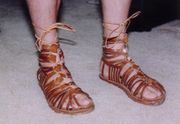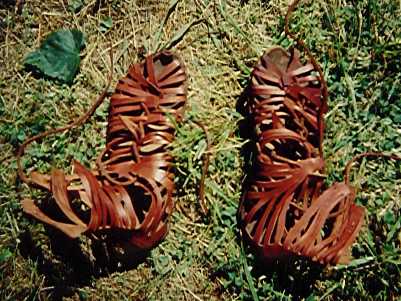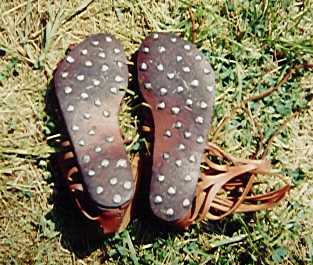Caligae
(copy from website) |
(cat) |
||
| Line 18: | Line 18: | ||
Before cutting good leather, make a working mock-up out of heavy cloth. Do not make the soles too wide; trace your foot and cut the soles narrower by 1/4" on each side. Make the tabs extra long and the slits shorter than necessary, and adjust them later. | Before cutting good leather, make a working mock-up out of heavy cloth. Do not make the soles too wide; trace your foot and cut the soles narrower by 1/4" on each side. Make the tabs extra long and the slits shorter than necessary, and adjust them later. | ||
| + | |||
| + | [[Category:Clothing and Equipment]] | ||
Revision as of 04:14, 18 September 2006
There was a wide variety of shoes and sandals for men and women. Most were constructed like military caligae, with a one-piece upper nailed between layers of the sole. Many had large open-work areas made by cutting or punching circles, triangles, squares, ovals, etc. in rows or grid-like patterns. Others were more enclosed, having only holes for the laces. Some very dainty women's and children's shoes still had thick nailed soles.Some shoes had a one- or two-piece upper of soft leather which enclosed the foot like a modern shoe. The edges were nailed between the sole layers. Traditionally, those worn by patricians, senators, and magistrates were called calcei, while common people wore perones. But there is much confusion in terminology and most shoes which have nailed soles and are not caligae nor sandals are referred to as calcei. "Calcei senatorii" had soft leather uppers and were secured by wide straps which passed under the foot and criscrossed up the lower leg. They were red with small ivory crescents attached. Equestrians are shown wearing an identical style, but apparently black in color.
One-piece shoes called carbatinae were shaped like caligae / Calcei, but had no outer or inner soles added. Sandals were generally called soleae, and had nailed or stitched soles. It is possible that heavy nailed shoes were for outdoor wear, while lighter sandals and carbatinae were worn around the house.
Besides open-work on the leather, shoes and sandals could be dyed, tooled, embossed, or even have gilded designs.
Socks (udones) were sewn of woven cloth, and could be worn for warmth or as decorative items. In the latter case they would be brightly colored so as to show through the ornate open-work of the shoes, and might leave the toes and heel exposed. Socks worn strictly for warmth were more likely fully closed and not necessarily so colorful. Fancy shoes could also have a colorful cloth lining, eliminating the need for socks.
Military Caligae
These heavy sandals are the classic Roman army boot. Numerous examples have been found at first-century sites.
Patterns and materials are available, and construction involves a lot of careful cutting but is otherwise straightforward. The upper is cut from a single piece of 2 to 6-ounce leather, well-oiled or waxed to prevent decay. The sole is 1/2" to 3/4" thick and is made of several thick layers, with the upper sandwiched between the top two. The layers are held together with hobnails; lay them on an anvil or flat piece of steel, and drive the nails into the sole so that the points go through the innermost layer and bend over as they hit the steel. Cover the clenched points with an insole of thin leather, securing it in place with a few stitches. Complete the shoe by sewing up the heel seam with a butted or overlapped seam.
The domed iron hobnails should be about 1/4" to 1/2" in diameter. The heads need not be perfect hemispheres; irregular, flatter, or more conical shapes are acceptable. World War I or II-style hobnails will work, or "Antique Nails" from some hardware stores. Upholstery tacks are not durable enough.Before cutting good leather, make a working mock-up out of heavy cloth. Do not make the soles too wide; trace your foot and cut the soles narrower by 1/4" on each side. Make the tabs extra long and the slits shorter than necessary, and adjust them later.


